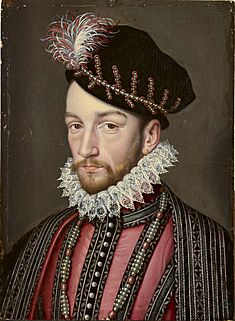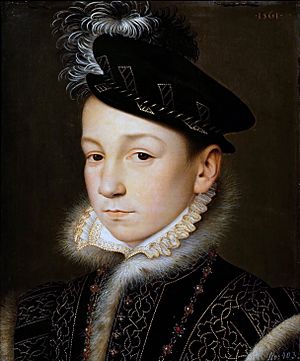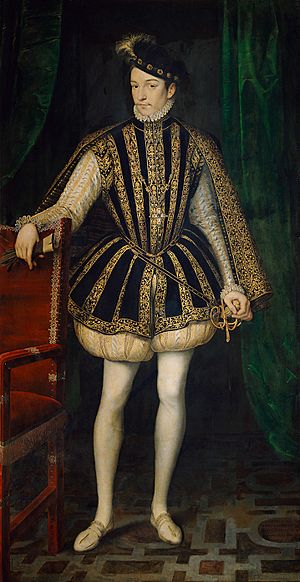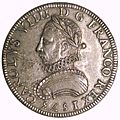Charles IX of France facts for kids
Quick facts for kids Charles IX |
|||||
|---|---|---|---|---|---|

Portrait after François Clouet, c. 1572
|
|||||
| King of France (more...) | |||||
| Reign | 5 December 1560 – 30 May 1574 | ||||
| Coronation | 15 May 1561 | ||||
| Predecessor | Francis II | ||||
| Successor | Henry III | ||||
| Regent | Catherine de' Medici (1560–1563) | ||||
| Born | 27 June 1550 Saint-Germain-en-Laye, France |
||||
| Died | 30 May 1574 (aged 23) Vincennes, France |
||||
| Burial | 13 July 1574 Basilica of St Denis, France |
||||
| Spouse |
Elisabeth of Austria
(m. 1570) |
||||
| Issue | Marie Elisabeth of France Charles, Duke of Angoulême (illegitimate) |
||||
|
|||||
| House | Valois-Angoulême | ||||
| Father | Henry II of France | ||||
| Mother | Catherine de' Medici | ||||
| Religion | Catholicism | ||||
| Signature |  |
||||
Charles IX (born Charles Maximilien; 27 June 1550 – 30 May 1574) was the King of France from 1560 until his death in 1574. He became king after his older brother, Francis II, passed away. Charles was one of the last kings from the House of Valois royal family.
Charles's time as king was marked by major conflicts between Protestants and Catholics in France. These disagreements led to a series of civil and religious wars. A terrible event called the massacre of Vassy in 1562 started these wars. In 1572, Charles tried to bring peace by arranging a marriage. His sister, Margaret, was to marry Henry of Navarre, a powerful Protestant leader.
However, this plan went wrong. Many Protestant leaders came to Paris for the wedding. A few days later, a terrible event known as the St. Bartholomew's Day massacre happened. Many Protestant leaders were killed. Historians still debate how much Charles was directly involved. This event severely hurt the Protestant movement, and the religious wars started again. Charles tried to take advantage of the situation by ordering the siege of La Rochelle, a Protestant stronghold, but he could not capture it.
Charles's mother, Catherine de' Medici, a strong Catholic, greatly influenced his decisions. She first supported religious tolerance, but after the St. Bartholomew's Day Massacre, she encouraged the persecution of Protestants. The massacre deeply affected Charles. Historians believe it caused his health to get worse over the next two years. Charles died from tuberculosis in 1574. He had no sons who could legally inherit the throne. His brother, Henry III, became the next king.
Contents
Early Life and Becoming King
Birth and Childhood

Charles Maximilien was born on 27 June 1550 at the Château de Saint-Germain-en-Laye. He was the third son of King Henry II of France and Catherine de' Medici. Charles was the fifth of their ten children. From birth, he was known as the Duke of Angoulême. After his older brother Louis died as a baby, Charles became the Duke of Orléans.
The royal children were raised by special guardians. On 14 May 1564, Charles received the Order of the Garter, a special award from England.
Becoming King
Charles's father, King Henry II, died in 1559. Charles's older brother, King Francis II, then became king. But Francis II died just a year later, in 1560. Charles was only ten years old when he was declared king on 5 December 1560.
Because Charles was so young, his mother, Catherine de' Medici, was appointed to rule France for him. She had a lot of power as the regent. On 15 May 1561, Charles was officially crowned king in the cathedral at Reims.
Religious Wars and Challenges
First War of Religion
Tensions with Protestants
In 1560, some Protestant nobles planned to kidnap King Francis II. They also wanted to arrest two powerful Catholic leaders, Francis, Duke of Guise, and his brother. This plan, called the Amboise conspiracy, was discovered. Hundreds of Protestants were executed. This led to more violence between Protestants and Catholics.
Catherine, the regent, tried to make peace. She held a meeting called the Colloquy at Poissy. When that failed, she gave some rights to Protestants in the Edict of Saint-Germain in January 1562. However, on 1 March 1562, the Massacre of Vassy happened. The Duke of Guise and his soldiers attacked and killed or wounded many Protestant worshipers. This event is seen as the start of the French Wars of Religion.
Louis of Bourbon, a Protestant leader, prepared for war. He used the Wassy massacre as a reason to take control of several towns. In response, the monarchy took back the rights they had given to Protestants. After major battles, Catherine helped arrange a truce. This led to the Edict of Amboise in 1563.
Time of Uneasy Peace

After the first war, there were four years of uneasy peace. During this time, Catherine brought different groups together to recapture Le Havre from the English. After this victory, Charles declared himself old enough to rule in August 1563. This officially ended his mother's regency. However, Catherine still played a very important role in politics and often guided her son.
In March 1564, Charles and his mother began a long trip around France. This trip lasted two years. During this journey, Charles IX issued the Edict of Roussillon. This law made January 1st the official start of the new year across all of France.
Later Wars of Religion
War broke out again in 1567. This happened after Charles added 6,000 Swiss soldiers to his personal guards. Protestants feared a Catholic attack. They tried to kidnap the king and took over several cities. They also killed Catholics in Nîmes in an event called the Michelade. The Battle of Saint-Denis was a defeat for the Protestants. The short war ended in 1568 with the Peace of Longjumeau.
However, the rights given to Protestants were not popular. This led to them being cancelled and the war starting again. Other countries got involved, with England and the Dutch supporting Protestants. Spain and the Pope supported Catholics. Finally, France's money problems and the king's wish for peace led to another truce. This was the Peace of Saint-Germain-en-Laye in August 1570. It again gave some rights to Protestants.
Marriage and Family
On 26 November 1570, Charles married Elisabeth of Austria. They had one daughter, Marie Elisabeth. In 1573, Charles had an illegitimate son, Charles, Duke of Angoulême, with his mistress, Marie Touchet.
The St. Bartholomew's Day Massacre
After the Peace of Saint-Germain-en-Laye in 1570, King Charles began to listen more to Admiral Gaspard de Coligny. Coligny was a powerful Protestant leader. However, Catherine, the king's mother, worried about Coligny's growing influence. She was especially concerned because he wanted an alliance with England and the Dutch. Coligny was also hated by Henry, Duke of Guise, who believed Coligny had ordered his father's murder.
As part of the peace agreement, a marriage was arranged. Charles's sister, Margaret of Valois, was to marry Henry of Navarre. Henry was a leading Protestant and would later become King Henry IV. Many Protestant nobles, including Admiral de Coligny, came to Paris for the wedding on 18 August 1572.
On 22 August, someone tried to kill Coligny but failed. This made everyone in Paris very nervous. Both the visiting Protestants and the Parisian Catholics feared an attack from the other side. In the early morning of 24 August 1572, the Duke of Guise acted to avenge his father. He murdered Coligny in his home. This act quickly led to widespread violence. Mobs began a systematic killing of Protestants, known as the St. Bartholomew's Day massacre. This terrible event lasted five days. Henry of Navarre survived by agreeing to become Catholic. Over the next few weeks, the violence spread to other cities in France. In total, thousands of Protestants were killed.
Although the massacres weakened Protestant power, they also restarted the wars. The fighting only stopped after the Edict of Boulogne in 1573. This law gave Protestants forgiveness and some religious freedom. However, in 1574, there were more Protestant uprisings. This set the stage for another round of war.
Health Decline and Death

After the massacre, the king's health, both mental and physical, became much worse. His moods changed often. Sometimes he would boast about the massacre. Other times, he would say the screams of the murdered Protestants kept ringing in his ears.
Charles's physical health, which was already weak due to tuberculosis, got worse by the spring of 1574.
Charles IX died at the Château de Vincennes on 30 May 1574. He was only 23 years old. His younger brother, Henry, Duke of Anjou, had recently become King of the Polish-Lithuanian Commonwealth and was away from France. So, their mother Catherine again became the regent until Henry returned from Poland.
Many years after his death, in 1625, a book Charles wrote about hunting was published. It was called La Chasse Royale. This book is still a valuable source for people interested in the history of hunting dogs and hunting practices.
See also
 In Spanish: Carlos IX de Francia para niños
In Spanish: Carlos IX de Francia para niños
- Catherine de' Medici
- Charles IX's grand tour of France
- Louis Duret
Images for kids



